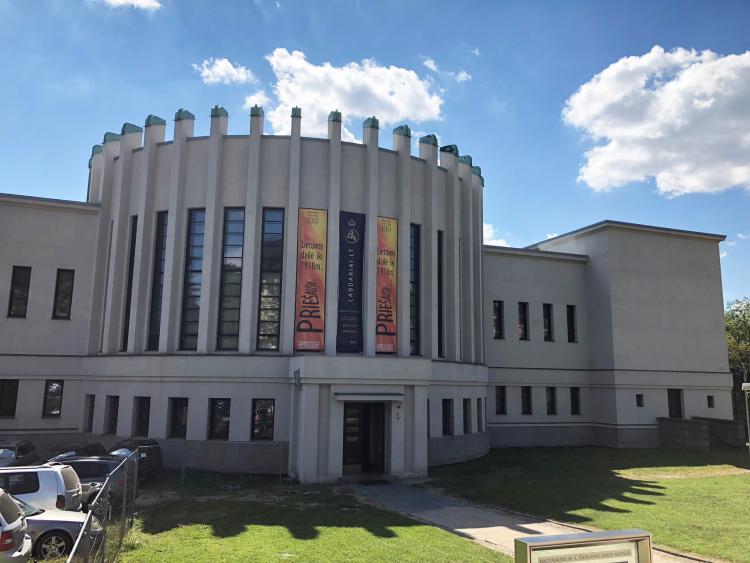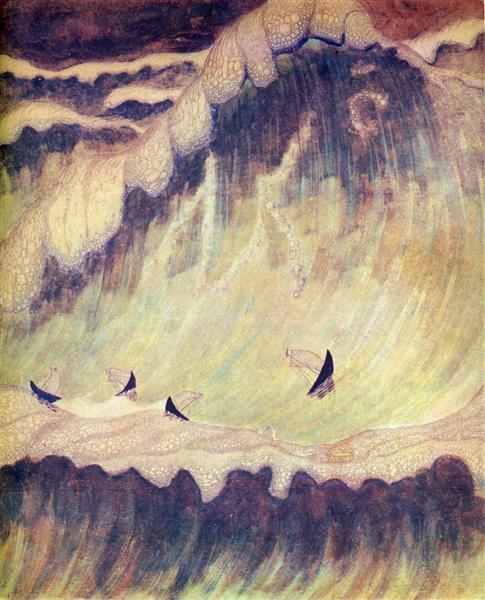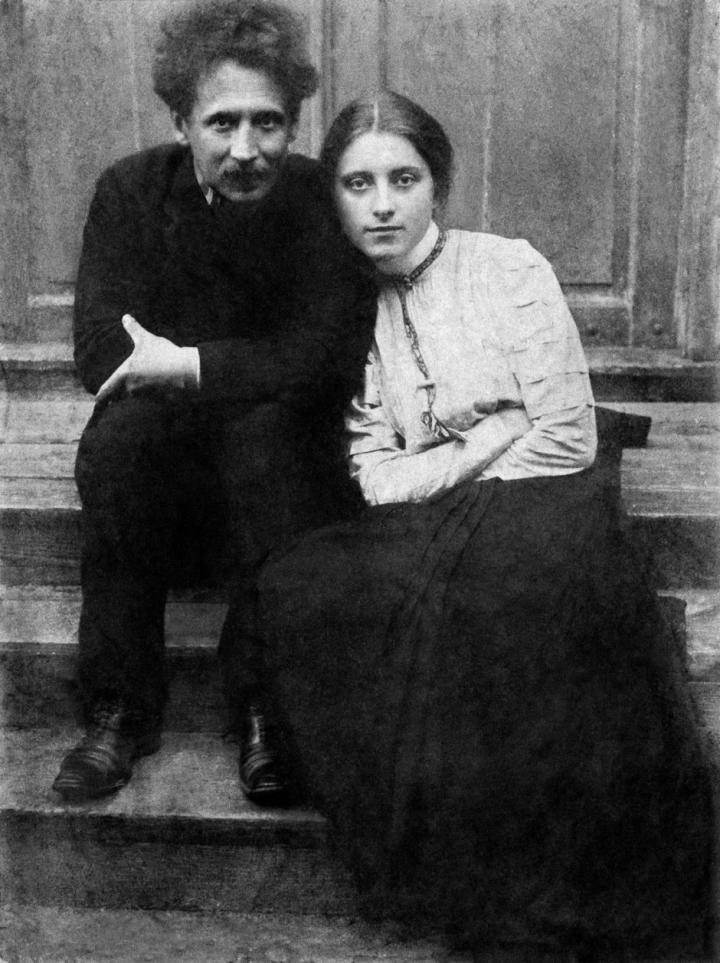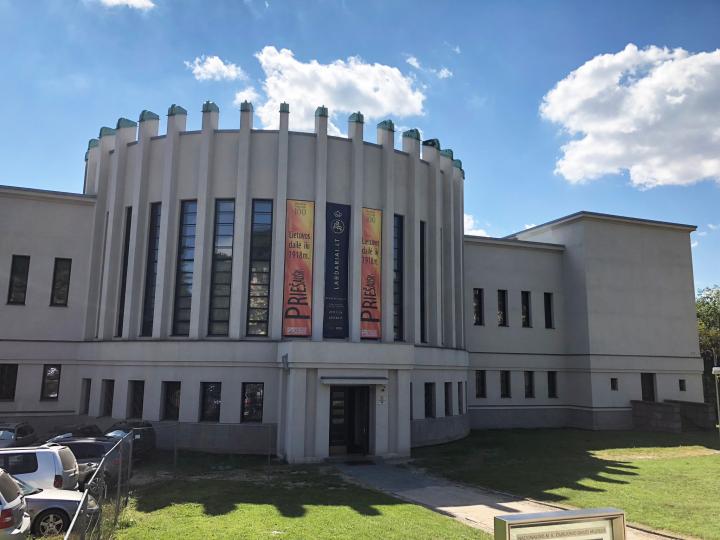Enter a cosmic universe created by the symbiosis of both art and music. Lithuanian composer and artist, M. K. Ciurlionis, used this intentional association of art with music and vice-versa to create a sensation that goes beyond the medium of art or music to engender a Lithuanian national cultural revolution at the turn of the 20th century.
Text
Have you ever regarded a work of art, such as a painting of a large giant wave in the ocean curling so high to capsize a small and insignificant looking vessel and at the same time imagined hearing a whole symphony of music behind it? Or have you ever closed your eyes while listening to sonorous music and imagined a giant wave in the ocean about to capsize a small insignificant vessel? Artists and musicians at the turn of the 20th century, particularly across Europe, were experimenting on this symbiosis or correlation between different mediums of art: Synaesthesia. Synaesthesia is the ascribing colours to sounds and vice versa.1 M.K. Ciurlionis was a crucial Lithuanian artist and composer that advanced this art form developing in Europe at the turn of the 20th century.
Text
Art, music and activism
Additionally, Ciurlionis is considered one of the most important actors in the Lithuanian national cultural rejuvenation movement. His art depicted Lithuanian landscapes, and his music compositions brought Lithuanian folk songs into musical compositions. His art and music served as the leading proponent in the Lithuanian national cultural movement that emerged at the turn of the 20th century.
Text
Passion and activism
Through his passionate relationship with his wife, Sofija, they served as a team that advanced Lithuanian national culture at the time when there was limited advancement in modernizing and developing Lithuanian institutions that advanced Lithuanian art, literature and music at the national level. The only deterrent to Ciurlionis’ role in his artistry, music and activism was the fact he went through life unrecognized and financially insecure, which impacted his artistry and musicianship. He tragically died from exhaustion at a very early age. Thus, this article will be a brief biography of M.K. Ciurlionis, highlighting his most important aspects of his life: The synaesthesia of his music and art, his leading and crucial role in the Lithuanian national cultural movement, and his deep relationship with his wife Sofijai.
Synaesthesia in Čiurlionis' music and art
Text
Avant Garde Art and Music
Ciurlionis’ synaesthesia approach to music composition and artistry served as the avant garde form of art at the turn of the 20th century. Buccio describes how Ciurlionis used musical terminology in the titles for his cycles of paintings, while associating imaginative and vivid descriptions for the titles of his musical compositions, which illustrates an intention to evoke a conceptual meaning beyond the sensation of sounds within his music and vice-versa within his artwork.2 A clear example of his synaesthesia approach to incorporating and correlating art into music and vice-versa is that Ciurlionis created the cycle of paintings, titled “Sonata of the Sea,” and titled his music composition the symphonic poem “The Sea.”
Text
The Performance of Synaesthesia
His art and music were clearly intended to be exhibited together for an audience through the form of synaesthesia. Ciurlionis performed his symphonic poem “the Sea” accompanied with “the Sonata of the Sea,” a cycle of landscape pictures in 1909 in St. Petersburg. This is described as the newest description of the genre of synaesthesia, incorporating art into the sphere of music and the reverse.3 At the time, St. Petersburg was the centre of European art and intellectualism at the turn of the century. Ciurlionis clearly pioneered this new form of art.
Text
Role of Synaesthesia in Cultural Advancement
Ciurlionis viewed art and music as a natural reflection of both a society’s physical landscape and cultural conditions. In his article About Music, Ciurlionis connects the role of music in cultural development. “The peoples who live in the mountains sing differently from the peoples who live on the shores of the Jura; the peoples who live in the dark woods sing differently from those who have to travel in the meadows of the plains. In rich and fruitful lands there is a different song, and a different song again where it is necessary to dig hard for bread and where starvation is common”4. Perhaps the correlation between art and music serves as the duality of the synaesthesia approach. Art represents the physical landscape of a society, while music represents the cultural aspects of a society. This correlation expresses the role of the art of synaesthesia in developing a national cultural identity for a society that has not yet advanced their culture into a nationalized movement.
Lithuanian national cultural movement
Text
Folk Songs as a Foundation
In Ciurlionis’ article About Music, he explains why Lithuanian music has not developed into a cultural phenomenon. “Lithuanian music, we can say with confidence, has to come into its own, but today it is not there yet…Lithuanian music will continue to be found in folk songs”5. Associating folk songs with Lithuanian culture is essential for understanding how to advance Lithuanian interests, as folk songs are the foundation of Lithuanian culture.
Text
Adopting Folk Songs into a Modern Composition
Ciurlionis’ contribution to the Lithuanian national cultural movement was strongest in his adaptation of Lithuanian folk songs into modern musical compositions of his own creation. Ciurlionis adapted over sixty Lithuanian folk songs into choir compositions and around forty compositions for piano, serving to successfully amalgamate folk music into modern compositional music.6 Associating something with the deepest Lithuanian context advances the Lithuanian cultural development, for it connects Lithuanian society to what is being created in Lithuanian art and music. It serves to engender the preservation of Lithuanian culture into the future to serve Lithuanian interests.
Text
Social Justice for Lithuania
Ciurlionis’ experiences as identifying as Polish in culture and discrimination as a Lithuanian in Warsaw and Leipzig led him to develop a sense of social justice for Lithuanian rights. He formed a choir for the Warsaw Lithuanian Mutual Aid Society, and he became the Vice-President of the Lithuanian Art Society in 1907.7 Ciurlionis was effectively active in generating Lithuanian interest groups to advance and enhance Lithuanian national culture and interests. By being the first to create these Lithuanian art groups, Ciurlionis is one of the essential actors advancing the Lithuanian national cultural movement.
Text
Devotion to the Lithuanian National Cultural Movement
Sofija, Ciurlionis’ wife, describes Ciurlionis’ temperament about his role in evolving and developing Lithuanian national culture. “After the first art exhibition, it suddenly became clear to him that his place in Lithuania is in Vilnius, but he was pushed as if it were a categorical imperative to work here in the field of art, to awaken, to raise, to show people what they themselves can create. Creating a Lithuanian choir in Vilnius seems to be his first goal”8. Ciurlionis viewed the role of his creativity in producing art and music to generate a cultural revolution in a Lithuanian national context as more important than taking a more comfortable and financially secure role where he would be unable to establish a Vilnius choir and express his deepest ideas and concepts for Lithuania.
Sofija, Ciurlionis’ wife, describes Ciurlionis’ temperament about his role in evolving and developing Lithuanian national culture. “After the first art exhibition, it suddenly became clear to him that his place in Lithuania is in Vilnius, but he was pushed as if it were a categorical imperative to work here in the field of art, to awaken, to raise, to show people what they themselves can create. Creating a Lithuanian choir in Vilnius seems to be his first goal”8. Ciurlionis viewed the role of his creativity in producing art and music to generate a cultural revolution in a Lithuanian national context as more important than taking a more comfortable and financially secure role where he would be unable to establish a Vilnius choir and express his deepest ideas and concepts for Lithuania.
His Relationship with Sofija: Passion, Romance and Tragedy
Text
Their First Encounter
Ciurlionis and Sofija first met at a Vilnius music hall that invited around 70 Lithuanian intellectuals, which was unprecedented in Vilnius.9 In fact, it was Sofija, as a member of the Lithuanian journal “Viltis” and active member in the Lithuanian national cultural movement, who ensured Ciurlionis was invited to perform his own music composition as part of the event.10 Sofija was introduced to Ciurlionis and after understanding that Sofija speaks Lithuanian, Ciurlionis asked her to teach him Lithuanian. Sofija describes the anecdote in her memoirs. “He then sat down next to me and said:”…“I have decided that you will teach me Lithuanian”11. Sofija’s reaction was very elated. She states in her memoirs: “There are such words such phrases in life, which nothing in the memory obscures or completes; not only do the words remain alive, but the timbre of the voice and the look in the eyes – the light smile of the lips”12. This is a crucial moment in each of their lives, as they meet each other on a level that bonds them together instantly for life. Sofia and Ciurlionis were clearly deeply drawn to each other for their shared passion to advance Lithuanian culture, and for the enjoyment of art and music itself.
Text
Romance Bonds Them Together
Andriusyte-Zukiene effectively describes the passionate bond that attracted each of them together and developed between Sofija and Ciurlionis. “Romantic fantasy brings both of them into a strong current, especially when they both shared their thoughts about the pursuit of the new art, about the flights of a spirit in a limitless space, on the edges of imagination and inspiration”13. The creative process of art and music and literary journalism that both Sofija and Ciurlionis together deeply engaged in served to propel their aspirations for a Lithuanian society of limitless possibilities and opportunities that were severely repressed by political forces until now.
Text
The Passion Between Them
The deep passionate relationship between Ciurlionis and Sofija is significantly illustrated by Sofija’s description of their first engagement. “I sat down on the couch, closed my eyes, Konstantin improvised…The music stopped – the evening twilight fills the room – in that twilight, it seems to me, the tones of music are still swirling. I got up – the unspoken happiness and endless sadness on earth is just a smell to me. I got up from my seat and, running behind him, I was going to caress him with my head tilted back, and bending down I kissed his proud forehead lightly. He pressed my hands to his lips – without a word. A limit – which neither of us wants to cross. After a few hours I said: I have to go. – I will accompany you. And we went without a word”14. Sofija even associates the aspect of synaesthesia with their first engagement. The power of synaesthesia of art and music connects people into a deep emotional association. Activating more than one sense in artistry engenders a sense of freedom that is deeply impactful on an audience.
The Tragic and Untimely Death of Ciurlionis
Text
Exhaustion from Devotion to his Compositions
In 1909 Ciurlionis went to St. Petersburg alone without Sofija. Ciurlionis was advised that it was too expensive for them to both travel and stay together in St. Petersburg. The financial state of Ciurlionis was severely impacting his relationship with Sofija, and negatively affecting his artistry and musicianship. A close friend in St. Petersburg stated: “After working 24 and sometimes 25 hours daily, Ciurlionis often said that he had so many new paintings that he was afraid he would not be able to paint them all. Apparently, he felt that death was imminent”15 . Being away from the person that has the deepest emotional association with him would have had a significant effect on Ciurlionis’ mental health that was clearly deteriorating. If Sofija had accompanied Cirulionis to St. Petersburg, would Ciurlionis’ compositions have been more fruitful? Would Sofija’s presence have soothed Ciurlionis’ depression and anxiety? Would Sofija’s presence been enough to prevent Ciurlionis from working until exhaustion? Their deep emotional association would suggest that Sofija’s presence would have dramatically enhanced Ciurlionis’ artistry and would have been significantly therapeutic for Ciurlionis.
Text
The Tragic and Untimely Death of Ciurlionis Ciurlionis collapsed from exhaustion and was sent to a sanitorium near Warsaw to be close with Sofija. Sofija describes his final moment.16 “The priest came and asked me about his life and approached him, preparing to give him the last rites. Two large tears rolled down from M.K. Ciurlionis’ eyes and stood on his cheeks. The priest administered the last anointing with Holy Oils, and the bright rays of the spring sun wiped away his [Ciurlionis] parched face and dried the last tears”17. Ciurlionis was able to die with Sofija by his side. Since they shared such deep passion for each other and their movement to advance Lithuanian national culture, being together for the final act must have meant so much to them.
Conclusion
Text
Ciurlionis’ untimely death at an age in his thirties was not only devastating for his wife and family, but devasting for the Lithuanian art and music society and more importantly the Lithuanian national cultural movement. Upon the death of Ciurlionis in 1911, the Lithuanian journal Apollon awarded Ciurlionis as the primary initiator of Young Lithuania, the Lithuanian national identity and cultural rejuvenation movement.18 For Lithuanians, even today, Ciurlionis is “a great symbol of national pride; around the world, whatever their social or political systems, Lithuanians hail him as a genius”19. In his short life through his exhaustive devotion to his art and music in creating a Lithuanian cultural universe, Ciurlionis was successful after all in his achievements of advancing Lithuanian interests and a novel form of art: synaesthesia.
Listen to Ciurlionis’ “The Sea” by the Lithuanian National Symphony Orchestra, conducted by Modestas Pitrenas.

the M.K. Ciurlionis National Art Museum. Pofka / Pofka, CC BY-SA 4.0
the M.K. Ciurlionis National Art Museum. Pofka / Pofka, CC BY-SA 4.0













